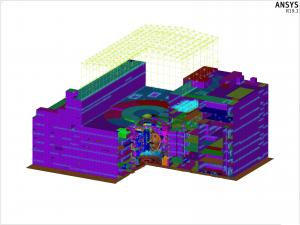Collaboration helps to keep ITER on solid ground
At ITER, system designers have to ensure that their equipment will withstand earthquakes, large and small.
Equipment required for the safety of ITER has to be designed to an SL-2 earthquake, which corresponds to a seismic event predicted to occur only once every 10,000 years.
Responsibility for integrated seismic analysis lies with the Integrated Engineering Analysis Section, whose broader mission is to help define loads of various types. "Helping to define seismic loads is just one of our activities," says Section Leader Tyge Schioler. "We do the same for static electromagnetic fields, or transient electromagnetic loads during disruptions. And we help define thermal loads during transient events."
"We provide advice and support on methodology and best practices for analyses. We write documents that say how to perform an analysis, for example. And we also provide direct support, where a designer will come to us with a specific problem, and we give one-off recommendations."
To help analyze seismic loads, teams at ITER and the European Domestic Agency, Fusion for Energy, use a software package called ANSYS to build finite element models that relate acceleration to the natural frequencies of a given structure. The frequency of a structure is a function of mass and stiffness, where stiffness is a property defined by how far something moves when a given amount of force is applied. The smaller the movement, the stiffer the structure is said to be.
"When a structure is made out of just steel or concrete, modelling is easy," says Schioler. "However, most structures are made of several different materials, and our models have to take this heterogeneity into account. Our most complex model is the one that represents the ITER Tokamak and Tokamak Complex as a whole."
The baseline model of seismic loads in the Tokamak Complex
Not surprisingly, much of the seismic analysis focuses on defining the loads in the Tokamak Complex, which includes the Diagnostic and Tritium buildings, and the Tokamak building itself. These buildings sit on anti-seismic bearings, which isolate the structures horizontally. The anti-seismic pads are very stiff vertically, which means that if the ground moves vertically, the building will move with it. By contrast, the rubber in the anti-seismic bearings provides horizontal flexibility. When the ground moves horizontally, the building stays relatively still, and the equipment inside the building experiences very little acceleration.
"The internal deformation of the building structures is not so high," explains Schioler. "If you have a horizontal earthquake, the majority of the deformation will be in those anti-seismic bearings. The building is basically just a rigid block that sits on top of that."
Nevertheless, the equipment housed within the buildings has to be designed to withstand whatever movement there is. Since each piece of equipment behaves differently based on the natural frequency of the equipment, manufacturers need input to help them meet the requirements for safety and reliability.
The baseline for seismic loads was developed in 2016 through collaboration between ITER, Fusion for Energy, and Fusion for Energy contractors. "It took a huge amount of work to build the models and go through all the quality assurance processes," says Schioler. "We described how every part of the building moves during an earthquake. And we defined what's called the design floor response spectra, which are graphs of acceleration versus frequency. These graphs are given to equipment manufacturers to indicate the acceleration they need to consider in their designs of pumps, valves, cubicles and anything else that sits in a given location on a given floor."
The teams also use models to define relative displacements between different points. For example, the vacuum vessel might bounce up and down a little bit, and the building a bit less. This relative motion might compromise a pipe running between the two structures. But to predict how a pipe bends the models need more than just the relative motion: they also need information on the natural frequency of the pipe.
"Figuring out whether or not the pipe will be okay can actually end up being quite complex work," says Schioler.
A day in the life
"On a typical day, we advise equipment owners about how to interpret and apply the baseline loads," says Schioler. "We also very often provide advice on analysis methodology, and on the many ways calculations might be done. If somebody wants to outsource work, we can help with the technical specifications to make sure what they need is correctly specified."
The Integrated Engineering Analyses Section provides advice on the selection of codes and standards and any relevant material selection topics, including non-destructive testing for welds and joints. In some cases, equipment qualification is too complex to accomplish purely through calculations; instead, experiments must be performed—for example, a motor might be placed on a shaking table that simulates an earthquake to test the motor's reaction.
"Most importantly, our job is to quantify how safe the buildings and equipment are—and we rely on close partnerships to do that," says Schioler. "Fusion for Energy is responsible for the design of the civil structure. We look closely at what they do, and run calculations in parallel to make sure we come to the same conclusions. Together we have to assess this 300,000-tonne reactor building and check that every single bit of reinforced concrete in there will be okay in the event of an earthquake."
"This is an excellent example of successful cooperation between ITER, Fusion for Energy, and Fusion for Energy contractors," says Schioler. "We trust what they do. They trust what we do. We rely on them. We talk to each other all the time and make sure that we work together in a good way."


